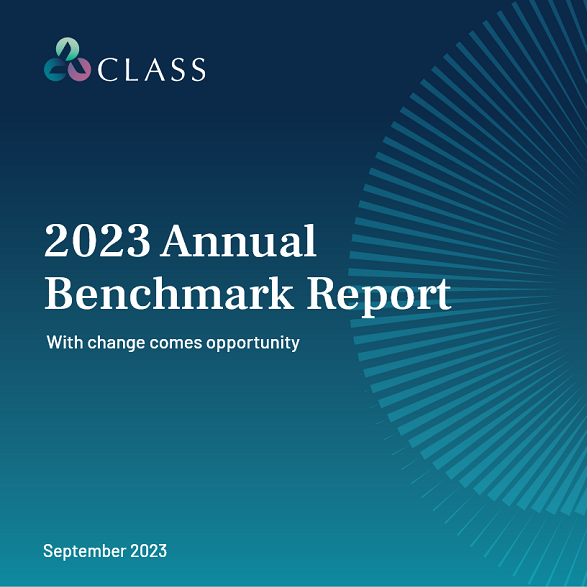
Class launches 2023 Annual Benchmark Report
Leading cloud-based wealth accounting and SMSF administration software provider Class has today released the 2023 Annual Benchmark Report, revealing younger generations continue to drive new establishments whilst retirees are experiencing the benefits of remaining in SMSFs and taking advantage of tax-free earnings.[1]
In FY23, Generation X (52.7%) and Millennials (23.7%) collectively drove 76.4% of new fund establishments, as total SMSFs grew to more than 610,000 funds and $880 billion in assets. SMSFs now comprise 25% of the $3.4 trillion superannuation industry.[2]
The research also found average non-concessional contributions for Class members in FY22 rose by 28.1%, resulting from several factors including downsizing contributions, rebalancing strategies, the indexation of contribution caps, and the removal of the work test for people under the age of 67.[3]
Class CEO Tim Steele said the Class Annual Benchmark report analyses the data behind the SMSF sector, providing key insights into the trends shaping the future of the industry.
“As a leading provider of SMSF software solutions, we’re in a unique position to leverage the data available through the Class platform and collaborate with industry leaders to deliver insights to help financial services professionals navigate the changing SMSF landscape and identify opportunities for their businesses and their clients.
“This year’s theme, with change comes opportunity, is reflective of an industry that continues to evolve, shaped by changing regulation and consumer needs.”
SMSF new establishments, growth and longevity
Steele said, “Our data clearly shows an ongoing upward trend in SMSF establishments driven by both Generation X and Millennials indicating they are highly engaged in wealth accumulation and planning for a better retirement.
“They’re realising the many benefits that SMSFs offer including flexibility, investment choice and control, as well as the opportunity to become more engaged in their retirement outcomes. They’re also seeing SMSFs as a cost-effective investment solution.
“Interestingly, the data also shows members aged 75 and over are choosing to stay in SMSFs for longer.”
Benefits of tax-free earnings in retirement phase
A comparison of statistics from APRA and Class highlights that members of SMSFs are significantly more likely to be using their superannuation to provide a tax-effective retirement income.
Steele added, “A high proportion of Class members (88%) 65 and over have moved their balances into pension phase and are therefore more likely to be taking advantage of tax savings and maximising their retirement benefits.[4]
“In contrast to APRA fund members, as of June 2022, nearly half of all members (49%) aged 65 and over have their entire account in accumulation phase despite the fact that they are eligible to move into pension phase and access tax-free earnings.”[5]
Proposed 15% tax on superannuation earnings for members with more than $3 million
As of 30 June 2023, 8% of SMSFs administered on Class have more than $3 million in super, approximately 1 in 4 of these funds hold direct property investments. Moreover, 80% of affected members are aged 65 and over.[6]
Steele continued, “The current legislation limits people’s capacity to make both concessional and non-concessional superannuation contributions, so there is a natural ceiling that restricts the amount that you can invest within super.
“While the proposed legislation is forecast to impact 0.5% of superannuation members (80,000), if the $3m super cap is not indexed, then due to compounding, this could very likely impact future generations.”
New trend reveals reverse gender gap
The report also reveals for Class members a reverse trend whereby women under 25 years of age have 4.1% higher balances than their male counterparts.[7]
Class General Manager of Growth Jo Hurley said, “For the first time, we looked at the gender gap over age range and, interestingly, we found the gender gap for women in their twenties was reversed. In fact, Class data for FY22 shows women at the start of their career have higher super balances than men.
“But once they reach the next age bracket, the trend reverses again where the gap is steep, and it becomes a real challenge to play catch up. That’s why it’s so important for women to start thinking about putting some simple yet effective strategies in place right away so that it becomes much easier to save for retirement.
“For example, if women were to begin making extra contributions into their super at the start of their career while they’re ahead, they’re more likely to benefit from a greater compounding effect of investment returns over time.
“It’s also important that people seek financial advice and preferably from an SMSF specialist, when establishing their own retirement fund to determine the most appropriate financial plan for their retirement objective.”
Top tips to help women grow super balances by Class General Manager, Growth Jo Hurley
| 1. Take advantage of opportunities to salary sacrifice or make voluntary after-tax contributions before and after taking any career break |
| 2. Continue contributing to super during parental leave or career breaks where possible |
| 3. Use the opportunity to catch-up concessional contributions when earnings are higher |
| 4. Pay attention to investment performance/returns on a regular basis |
| 5. Consider making a downsizer contribution when the time is right |
| 6. Seek professional advice on rebalancing strategies |
For a full copy of the Class 2023 Annual Benchmark Report, please visit here.
[1] Class Annual Benchmark Report: With Change Comes Opportunity
[2] 610,287 total funds (APRA Jun 30 Quarterly Statistics); 588,071 total funds (ATO March 31 Quarterly Statistics)
[3] Class Annual Benchmark Report: With Change Comes Opportunity
[4] Class Annual Benchmark Report: With Change Comes Opportunity, 1 in 8 (~12%) members aged 65+ have their entire balance in accumulation
[5] Refer to Australian Prudential Regulation Authority (APRA) 2023, Annual superannuation bulletin June 2015 to June 2022 (published on 31 January 2023), table 7d Membership Profile By Age And Members’ Benefit Bracket
https://www.apra.gov.au/annual-superannuation-bulletin
[6] Refer to Member age distribution of members having balances > $3m, page, 35
[7] Class Annual Benchmark Report: With Change Comes Opportunity


